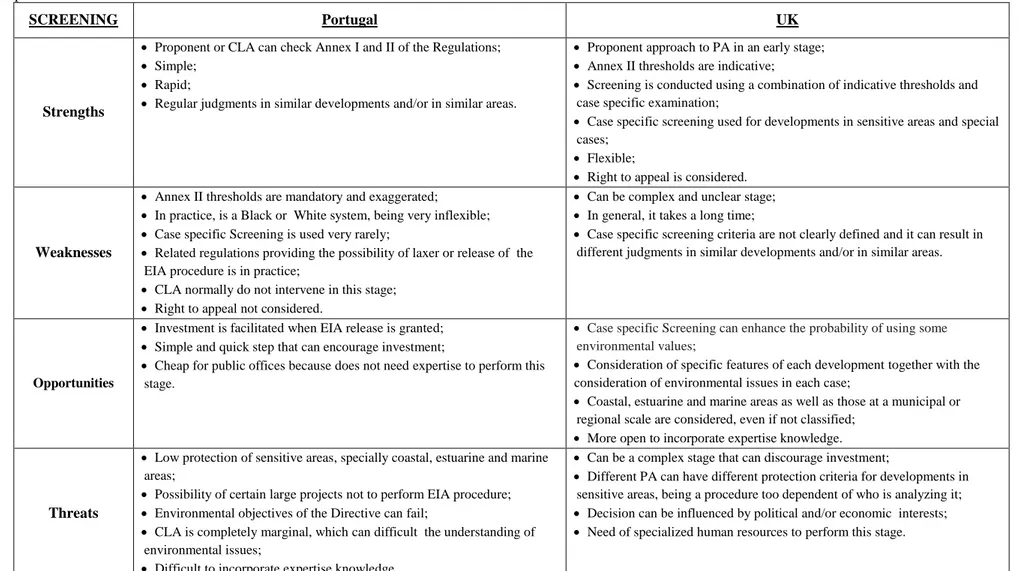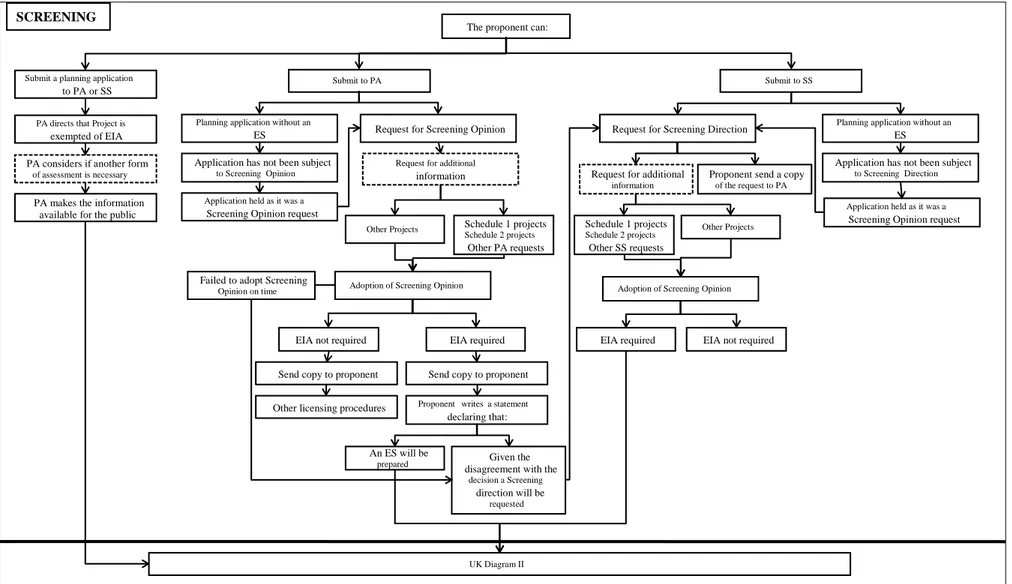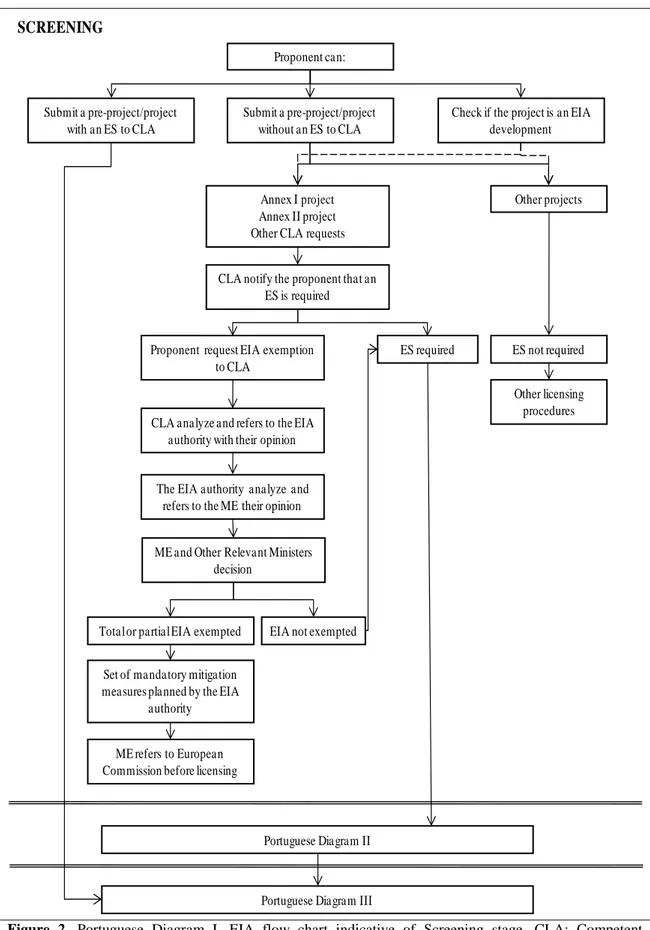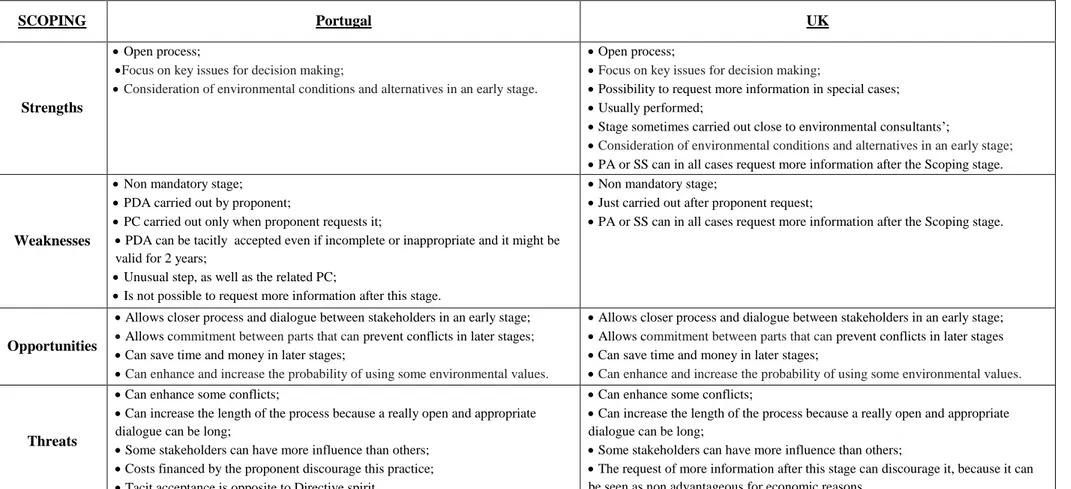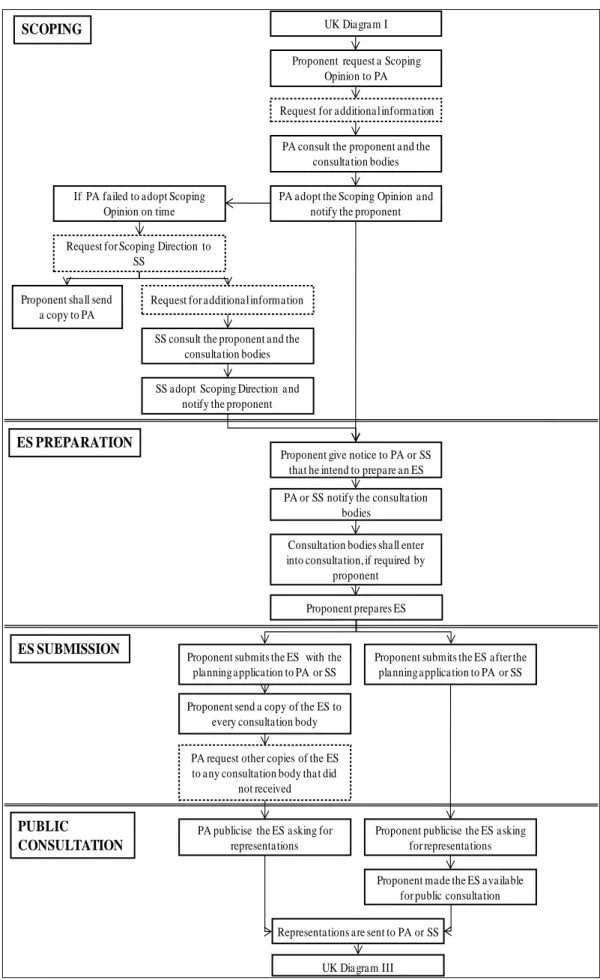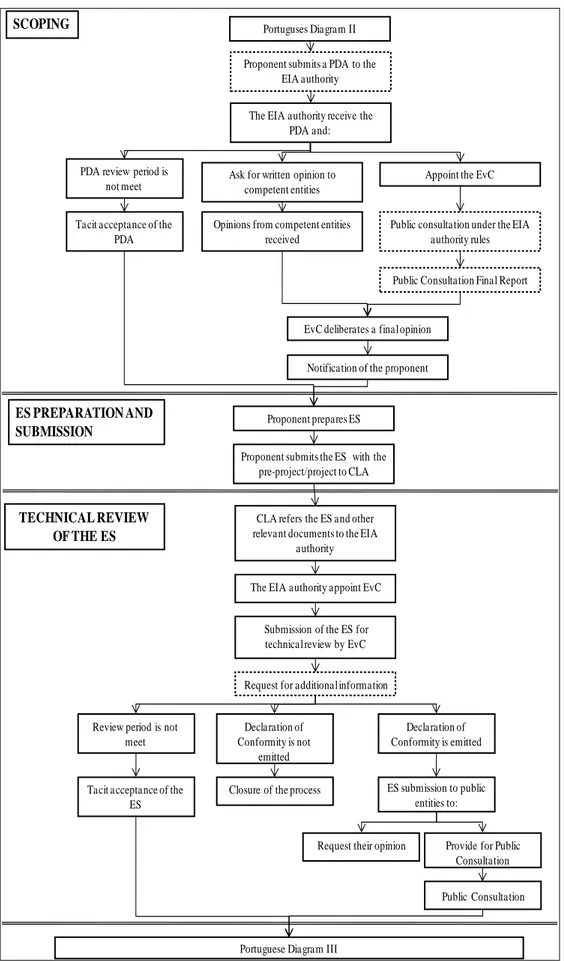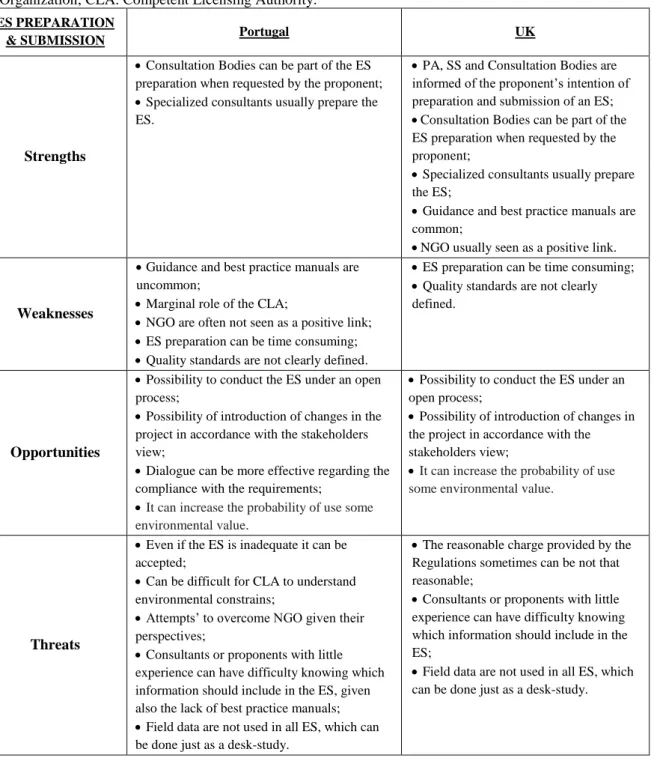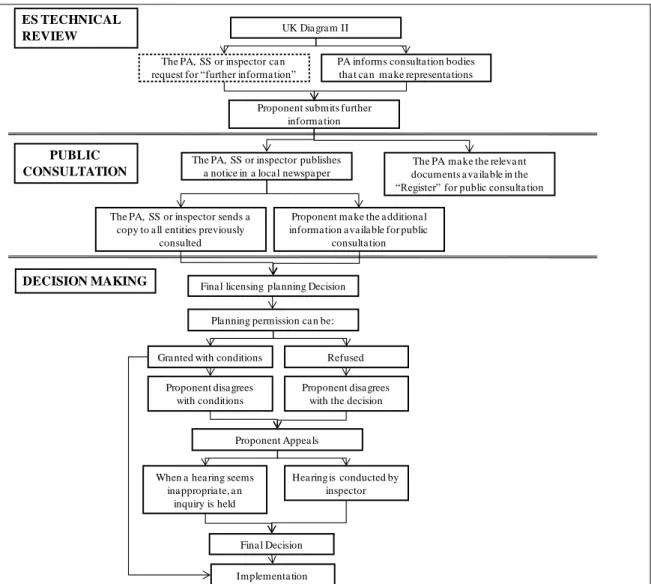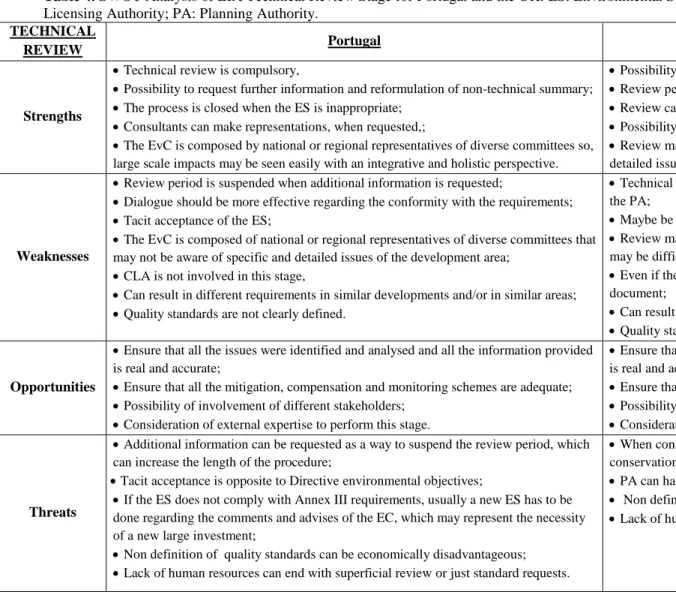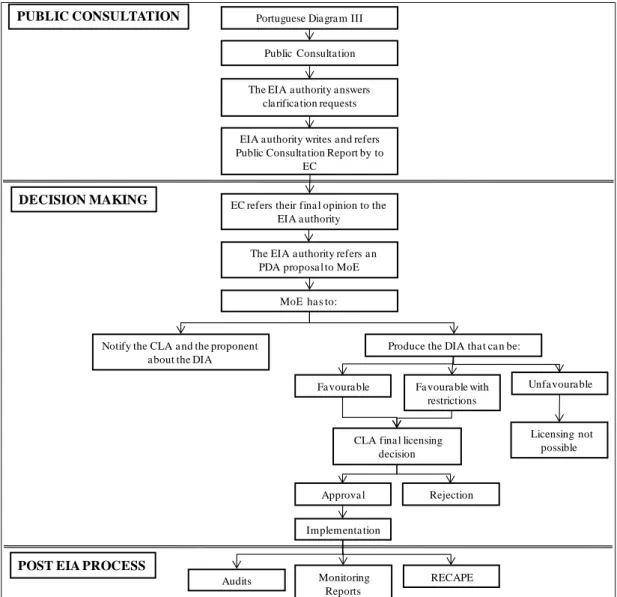UNIVERSIDADE DE LISBOA
FACULDADE DE CIÊNCIAS
DEPARTAMENTO DE BIOLOGIA ANIMALP
ROCESSES AND
P
RACTICE IN
E
NVIRONMENTAL
I
MPACT
A
SSESSMENT
:
A
C
OMPARISON
B
ETWEEN
P
ORTUGAL AND THE
U
NITED
K
INGDOM
Juliana Marino Barroso
MESTRADO EM ECOLOGIA MARINHA 2009
UNIVERSIDADE DE LISBOA
FACULDADE DE CIÊNCIAS
DEPARTAMENTO DE BIOLOGIA ANIMALP
ROCESSES AND
P
RACTICE IN
E
NVIRONMENTAL
I
MPACT
A
SSESSMENT
:
A
C
OMPARISON
B
ETWEEN
P
ORTUGAL AND THE
U
NITED
K
INGDOM
Dissertação orientada por:
Professor Doutor Henrique Cabral
Professor Doutor Mike Elliott
Juliana Marino Barroso
MESTRADO EM ECOLOGIA MARINHA 2009
i
iii
Several people were very important during this work; as so I would like to express my gratitude to them all, especially to:
Professor Henrique Cabral who, for the last 3 years, always had the door open to teach, help and advice in any occasion, especially during the last year; for taking the chance on me, for all the support, supervision, enthusiasm and confidence even in my moments of doubt.
Professor Mike Elliott for all the help, advises, supervision, availability and for the opportunity of letting me be part of IECS team during the last 10 months, which made me grow as a person and as biologist. Like someone told me one day “it was character
building”!
Everyone in IECS! It was a wonderful experience to know you all, and to experience the life of a biology technician. Particularly, to Nick Cutts who helped me so much in understanding the practice of EIA in the UK with all the chats and “2 minutes conversations”.
Rafa and Maria for all the friendship, companionship, support and nice times in the mud, so many times with the wonderful British weather conditions, but always with a nice and generous smile! Muito Obrigada!
The best housemates ever: Christina, Katrin and Vera, for all the good moments and great laughing during the last year. Without your friendship and patience, the bad times would not have been so easy to overcome.
All my friends, for making me smile and think that life is so breathtaking! Cátia, Kikas, Carlota, Jô, Mafalda, Joana (Mana), Miguel, Renato, Nélia, Sara and so many others, thank you for all the good times...
Hendrik, who showed me who I can be, what I want and where I want to be in life! Thank you for all the care, support, concern, love and great moments...
My family, for all the unconditional love, support, concern, friendship, advises, care, dedication and patience, for understanding the long times that I am not physically around. Principally, to my parents and brother, who always accept and support my decisions and points of view even when they do not understand or agree. Thank you for believe that I can, even when I have doubts. Thank you for always saying with enthusiasm, in those moments when life shows difficult crossroads, move on!, do it!, fight for what you believe!. Obrigada....
My great grandfather Zé Patraquim for all the guidance and inspiration!!! Thank you for showing me how we should live life: with honesty, hard work, conviction and humbleness. Thank you for being there to help me understand the moments when life gives great opportunities. Até sempre...
v
vii
APA: Agência Portuguesa do Ambiente, Portuguese Agency for the Environment; CCDR: Comissão de Coordenação de Desenvolvimento Regional, Regional
Coordination and Development Commission; CEC: Commission of the European Communities; CLA: Competent Licensing Authority;
DCLG: Department for Communities and Local Government;
DIA: Declaração de Impacte Ambiental, Environmental Impact Declaration; EC: European Commission;
ECJ: European Court of Justice;
EDP: Empresa Energias de Portugal; Portuguese Energy Company; EEA: European Environment Agency;
EEC: European Economic Communities; EIA: Environmental Impact Assessment; ES: Environmental Statement;
EU: European Union;
EvC: Evaluation Commission; GDP: Gross Domestic Product;
IAIA: International Association of Impact Assessment; ICM: Integrated Coastal Management;
ICNB: Instituto de Conservação da Natureza e Biodiversidade, Institute for Nature Conservation and Biodiversity;
IEMA: Institute of Environmental Management and Assessment; INAG: Instituto da Água; Portuguese Institute of Water;
IPA: Instituto Português de Arqueologia, Portuguese Archaeological Institute;
IPPAR: Instituto Português de Património Arquitectónico, Institute of Architectural Heritage;
MoE: Minister of the Environment; MS: Member State;
NEPA: National Environmental Policy Act; NGO: Non Governmental Organisation PA: Planning Authority
PC: Public Consultation;
PDA: Proposta de Definição do Âmbito, Portuguese Scoping Proposal; PIN: Projectos de Interesse Nacional, Projects with National Interest;
RECAPE: Relatório de Conformidade Ambiental do Projecto de Execução com a Declaração de Impacte Ambiental, Report on the Environmental Compliance with
the Environmental Impact Declaration; SEA: Strategic Environmental Assessment; SS: Secretary of State;
SWOT analysis: Strengths, Weaknesses, Opportunities, Threats analysis; UK: United Kingdom;
ix
xi
As áreas costeiras são zonas preferenciais para a instalação das populações humanas, atingindo densidades populacionais e Produto Interno Bruto (PIB) associados muito superiores a outras áreas do globo. Esta preferência deve-se, provavelmente, ao facto das zonas costeiras facultarem bens e serviços que proporcionam o bem-estar humano, contribuindo para taxas superiores de empregabilidade e de desenvolvimento de actividades económicas. É, também, por esta razão que estas áreas se encontram sujeitas a maiores pressões ambientais que se traduzem por impactes, muitas vezes, consideráveis em habitas importantes. Assim, o estado ecológico de habitats tais como estuários, lagoas costeiras, mares e oceanos abertos são, também, o reflexo de como as actividades antropogénicas são conduzidas nestas áreas.
A degradação das áreas costeiras pode resultar de actividades com origem no meio marinho, como por exemplo, pesca, aquacultura, dragagens, transportes, etc., ou com origem no meio terrestre, tais como, turismo, urbanização, run-off de origem urbana ou de agricultura, etc. Para combater esta degradação, as nações, individualmente ou em conjunto, implementam quadros legais que têm em conta os constrangimentos ambientais, aquando da tomada de decisão do desenvolvimento ou não, de determinada actividade ou projecto de construção. Em particular, na União Europeia (UE) existem actualmente um conjunto de Directivas de âmbito ambiental que têm como objectivo, gerir sustentadamente as áreas costeiras; são exemplos a Directiva de Avaliação de Impacte Ambiental (AIA) (85/337/CEE rectificada pela Directiva 97/11/CE), a Directiva Quadro da Água (2000/60/CE), a Directiva de Avaliação Ambiental Estratégica (AAE) (2001/42/CE) e a Directiva Quadro Estratégia Marinha (2008/56/CE).
A Directiva AIA prevê “a avaliação ambiental de projectos públicos e privados
susceptíveis de produzirem efeitos significativos no ambiente”. Esta Directiva tem um
papel relevante para as zonas costeiras uma vez que abrange um conjunto vasto de actividades que se desenvolvem preferencialmente nestas áreas. A Directiva AIA poderá, do mesmo modo, ter importância na aquisição de informação ambiental que poderá ser utilizada por outras Directivas ambientais, desde que bases de dados a nível regional, nacional e até europeu mantenham estas informações actualizadas e acessíveis, para que certos processos possam servir, também, como exemplo a outros desenvolvidos posteriormente.
Neste contexto, este trabalho teve como objectivo a avaliação e comparação da transposição e implementação e da prática relativas a AIA em dois Estados Membros (EM) da UE (Portugal e Reino Unido). Foram criados esquemas interpretativos da legislação em vigor nos dois EM, sendo analisado, no caso de Portugal, o Decreto-Lei (DL) 69/2000 de 3 de Maio com a alteração introduzida pelo DL 197/2005 de 8 de Novembro. Para o Reino Unido (i.e. Inglaterra, Escócia, Irlanda do Norte e País de Gales), definiu-se como exemplo o enquadramento legal de Inglaterra e País de Gales, uma vez que se encontram em vigor diferentes enquadramentos legais em cada país, sendo estes, no entanto, similares. Assim, considerou-se o The Town and Country
(Environmental Impact Assessment) (England and Wales) Regulations 1999, rectificado
pelo The Town and Country (Environmental Impact Assessment) (England and Wales)
(Amendment) Regulations 2000 e pelo The Town and Country (Environmental Impact Assessment) (Amendment) Regulations 2006.
Realizou-se uma análise FOFA (Fortes, Oportunidades, Fracos, Ameaças) para cada passo do procedimento de AIA (i.e. Definição da Aplicabilidade do Regime Jurídico de AIA, Definição do Âmbito, Preparação e Submissão do Estudo de Impacte Ambiental, Revisão Técnica do Estudo de Impacte Ambiental, Consulta Pública, Tomada de Decisão e Pós-Avaliação). Esta metodologia é frequentemente utilizada em gestão e economia, mas a sua simplicidade de utilização e praticabilidade leva a que seja, igualmente, usada noutras áreas do conhecimento permitindo obter, geralmente, bons resultados. Considerando alguns aspectos culturais, cívicos, políticos e administrativos dos EM em análise, foi ainda realizada uma análise empírica crítica, tendo por objectivo reconhecer a importância destes factores nos procedimentos de AIA e, por conseguinte, nos objectivos de desenvolvimento socioeconómico.
Através destas análises foi possível compreender que existem alguns pontos fracos do próprio regime regulamentar a diferentes níveis (Europeu e em cada EM) e que, noutros casos, é a aplicação prática da Directiva que diminui a sua performance. Deste modo, e de forma a melhorar o processo, propõem-se as seguintes medidas a nível Europeu: (i) clarificar conceitos abstractos usados na linguagem da Directiva, tais como “efeitos significantes”; (ii) abolir a possibilidade de usar limites compulsivos no Anexo II para áreas sensíveis sem a utilização conjunta de outras metodologias mais apropriadas para estas zonas; (iii) introduzir enquadramento legal visando a possibilidade de recorrer a decisões do processo de AIA durante e no final deste; (iv)
xiii
introduzir enquadramento legal para que a Definição do Âmbito seja obrigatória; (v) introduzir enquadramento legal referente aos requisitos mínimos para a realização de Consulta Pública; (vi) investir em, e dinamizar os procedimentos de Pós-Avaliação; (vii) determinar claramente qual o papel da AIA na Tomada de Decisão, para que se afirme com um papel mais determinante; (viii) constituir equipas especializadas e independentes, de forma a elaborar guias para desenvolver sistemas de controlo de qualidade do procedimento, que sendo ainda, responsáveis pela supervisão da sua utilização e (ix) investir em educação ambiental, promovendo novos programas em todos os EM.
As recomendações sugeridas para o melhoramento dos procedimentos de AIA no Reino Unido são: (i) desenvolver e melhorar um sistema claro para a Definição da aplicação do Sistema Jurídico em circunstâncias em que seja realizado com uma avaliação caso-a-caso, de forma a obter decisões com critérios semelhantes em todos os projectos; (ii) realizar o procedimento de Definição do Âmbito em, pelo menos, todos os projectos públicos, incentivando sua a realização noutros projectos sempre que possível; (iii) melhorar a eficiência dos mecanismos e o período de Consulta Pública, (iv) transformar o resumo não técnico num documento independente do Estudo de Impacte Ambiental; (v) introduzir um mecanismo de Pós-avaliação ligado à AIA, de forma a obter uma visão mais integrada e holística dos sistemas biológicos onde é utilizado; (vi) implementar bases de dados nacionais e /ou regionais facilitando, para isso, a submissão de todos os documentos relacionados com AIA em formato digital, sendo assim, mais acessíveis ao público; e (vii) implementar programas que incrementem o conhecimento e disponibilizem mais informação para todos os intervenientes, melhorando a percepção sobre problemas ambientais e a reputação dos procedimentos de AIA.
No caso de Portugal, as seguintes alterações no procedimento de AIA são propostos: (i) alterar a metodologia de Definição de Aplicação do Regime Jurídico, tornando-a mais flexível, e/ou alterando os limites do Anexo II para os casos especiais; (ii) introduzir guias e manuais de boas práticas aconselhando a realização da Definição do Âmbito, para que este passo se torne mais frequente; (iii) realizar o processo de Definição do Âmbito em todos, pelo menos, os projectos públicos, incentivando sua a realização noutros projectos sempre que possível; (iv) anular um dos sub-passos da Revisão Técnica do Estudo de Impacte Ambiental, realizando-a num só; (v) adoptar
uma atitude mais pró-activa na publicidade e condução da Consulta Pública, incentivando a sua realização, mais frequentemente, em passos iniciais do procedimento; (vi) abolir a aceitação tácita de qualquer documento; (vii) melhorar a qualidade e frequência com que são editados manuais de boas práticas relativos a AIA; (viii) melhorar o diálogo entre as partes interessadas, tornando-o menos formal; (ix) melhorar e reforçar o papel das Autoridades Competentes para o Licenciamento, tornando possível a sua aproximação ao procedimento de AIA, por exemplo, podendo participar nas Comissões de Avaliação; (x) implementar programas que incrementem o conhecimento e disponibilizem mais informação para todos os intervenientes, melhorando a percepção sobre problemas ambientais e a reputação dos procedimentos de AIA; (xi) fazer uso limitado e cuidado de regulamentos ligados à AIA que tenham como objectivo a não realização do procedimento ou que reduzam o espaço temporal em que pode ser realizado e (xii) submeter todos os documentos relacionados com AIA em formato digital, facilitando o acesso ao público.
De forma a apoiar a aplicação destas recomendações ou mesmo a elucidar alguns pontos menos esclarecidos, é necessário trabalho futuro para compreender a relação custo-benefício da realização do procedimento de AIA, tendo em conta a sua qualidade e eficiência. A avaliação da qualidade dos Estudos de Impacte Ambiental submetidos às entidades responsáveis, nas diferentes actividades, assim como, a relação que estes têm com a qualidade da tomada de decisão são outros pontos essenciais à compreensão e aceitação deste procedimento. Apesar da Pós-Avaliação não se encontrar contemplada pelo enquadramento regulamentar da AIA, é necessário analisar o custo-benefício da sua realização, para que seja incluída definitivamente, em caso de ser benéfica em termos ambientais e socioeconómicos.
A elucidação do papel da Directiva AIA quando utilizada em conjunto com outras Directivas, tais como a AAE, é essencial para que não se verifiquem sobreposições de encargos indigitados pelas diferentes Directivas. Em conjunto com a necessidade de compreender estes pontos, é indispensável implementar programas de informação e familiarização direccionados aos diferentes grupos interessados, de forma a melhorar a aceitação destes procedimentos. Desta forma, a Directiva AIA poderá dar um melhor contributo na gestão ambiental, em especial das zonas costeiras, sendo possível controlar ou diminuir as pressões exercidas nestas áreas resultantes do desenvolvimento socioeconómico.
xv
Palavras-Chave: Zonas Costeiras e Marinhas, Avaliação Impacte Ambiental, Enquadramento Legal; Análise FOFA, Portugal, Reino Unido.
xvii
xix
Human populations occupy intensively coastal areas throughout the world, probably given the goods and services provided by coastal systems that contribute significantly to employment and economic activities. Consequently, the Gross Domestic Product (GDP) associated to these areas is very high compared to inland areas, contributing clearly to human well-being. As a result, coastal and marine areas are subject to many environmental pressures and impacts.
Countries have long been responding to these pressures by implementing different regulatory frameworks. The European Environmental Impact Assessment (EIA) Directive is one of the most important environmental management tools applying by the European Member States (MS), because it covers many activities that are carried out in coastal areas but also because some basic environmental information, necessary to fulfil EIA requirements, might be used in other regulations.
Therefore, and because MS transposed and implemented the Directive dissimilarly, the present study analyzes the differences between the legal implementation and practice of the Directive in Portugal and in the United Kingdom (UK), considering this Directive as an example for another ones. To achieve this objective, detailed flow-charts were created based on national regulations and a SWOT (Strengths-Weaknesses-Opportunities-Threats) analysis was performed for each stage of the EIA procedure (e.g. Screening, Scoping, Environmental Statement Preparation and Submission, Technical Review, Public Consultation, Decision-Making and Post EIA Process).
During this work it was possible to understand that, in some cases, EIA good performance is affected by the regulations such as with the possibility of tacit acceptance or with the consideration of short periods of public consultation. In other cases, it is the practical application that influences the quality of the procedure, for example with the non compliance of the Scoping stage in the majority of the projects‟ development. Consequently, some recommendations were made for several points in order to improve those which are negatively influencing a good performance of the EIA procedure.
Keywords: Marine and Coastal Areas, Environmental Impact Assessment, Legal Frameworks, SWOT Analysis, Portugal, United Kingdom.
Processes and Practice in Environmental Impact Assessment: a Comparison of Portugal and UK 2
TABLE OF CONTENTS
ACKNOWLEDGEMENTS ... i LIST OF ACRONYMS ... v RESUMO ... ix ABSTRACT... xvii GENERAL INTRODUCTION... 4 REFERENCES: ... 8PROCESSES AND PRACTICE OF ENVIRONMENTAL IMPACT ASSESSMENT:
DIFFERENTIAL IMPLEMENTATION BY EUROPEAN MEMBER STATES... 12
INTRODUCTION: ... 15 GENERAL FEATURES: ... 17 SCREENING: ... 18 SCOPING: ... 24 ENVIRONMENTAL STATEMENT (ES) PREPARATION AND SUBMISSION: ... 29 TECHNICAL REVIEW: ... 32 PUBLIC CONSULTATION: ... 35 DECISION MAKING: ... 38 POST EIA PROCESS: ... 40 CONCLUSIONS AND RECOMMENDATIONS: ... 43 REFERENCES: ... 46
FINAL REMARKS ... 52
Processes and Practice in Environmental Impact Assessment: a Comparison of Portugal and UK
4
Processes and Practice in Environmental Impact Assessment: a Comparison of Portugal and UK
6
Human populations are mainly established in coastal areas, where almost half of the major cities of the world are located with an estimated population density of 1175 km-2 (Millennium Ecosystem Assessment, 2005). This is the result of the goods and services (direct or indirect benefits withdraw by human populations from different ecosystems) provided by coastal systems which are essential for human well-being; contributing significantly for employment rates and economic activities (UNEP, 1995; EEA, 2005).
Many authors identified goods and services associated to several ecosystems in their studies (e.g. UNEP, 1995; EEA, 2005; Millennium Ecosystem Assessment, 2005; Bartelmus, 2009) and Constanza et al. (1997) summarised them in 17 categories (gas regulation; climate regulation; disturbance regulation; water regulation; water supply; erosion control and sediment retention; soil formation; nutrient cycling; waste treatment; pollination; biological control; refuge; food production; raw materials; genetic resources; recreation and cultural), with at least 14 of these being related to coastal and marine environments. In the same study, it was estimated that ecosystems provide services representing at least US$33 trillion dollars annually. The marine and coastal systems services represent 63% of this value, showing that these areas include some of the most valuable and productive ecosystems in the world. In fact, the Gross Domestic Product (GDP) associated to these areas is estimated in US$8960 dollars per
capita (Millennium Ecosystem Assessment, 2005).
The dependence of humans on this added value results in a set of environmental pressures and impacts in coastal and marine systems. Thus, the ecological state of environments such as estuaries, coastal lagoons, seas and open oceans are a reflection of the way which anthropogenic activities occur in these areas (Constanza et al., 1999; Huber et al., 2003; Lotze et al., 2006; Osborn and Datta, 2006; Halpern et al, 2008; Cooper and MacKenna, 2009; Crain et al., 2009). The sources of degradation can be ocean-based activities such as: fisheries, transportation, aquaculture, dredging, oil extraction, etc.; or land-based activities such as: waste water treatment facilities, power plants, tourism, urbanisation, urban and/or agricultural run-off, etc. (UNEP, 1995; EEA, 2005; Osborn and Datta, 2006; Crain et al., 2009).
According to Halpern et al. (2008), over one third of the ocean is under medium intensity impacts and a small percentage (0.5%), mainly continental shelf and slope habitats is under very high impacts, since they are under the effect of land and ocean
Processes and Practice in Environmental Impact Assessment: a Comparison of Portugal and UK
based activities. Lotze et al. (2006) estimated that nowadays 90% of commercially important species are depleted and 65% of seagrass and wetlands habitats are destroyed, identifying an accelerated rate of species invasions‟ and degradation of water quality. But, it is only when human welfare started to be affected by the decrease of quality of coastal and marine habitats that populations started to realise that environmental regulatory frameworks are necessary to protect and preserve coastal and marine systems (EEA, 2005).
During the 1970 and 1980 the European policy making was mainly focused on punctual sources of pollution and degradation; nowadays there is a shift in this perspective and the focus is on integrative frameworks at a regional, national or global scale (McLusky and Elliott 2004). For example, the latest environmental policies promoted by European Union (EU) persuade sustainability (Fifth Action Programme, 1993) and a strategic approach for environmental protection (Sixth Action Programme, 2001), materialized, for example, by the implementation of the Water Framework Directive (2000/60/EC), Strategic Environmental Assessment (SEA) (2001/42/EC) and Marine Strategy Framework Directive (2008/56/EC). These integrated frameworks are many times difficult to implement given the complexity in the comprehension of the natural systems, the large number of partners involved with opposite interests and also given the flexibility of this policies which make implementation and enforcement at different scales (e.g. regional, national and European) hard to overcome (EEA, 2005).
The Environmental Impact Assessment (EIA) Directive 85/337/EEC amended by Directive 97/11/EC “is the assessment of the environmental effects of those public and
private projects which are likely to have significant effects on the environment”.
Although, first focused at the project level, the last amendment introduced the idea of “cumulative impacts” which brought a broader perspective into EIA, taking into account an assessment of the area of influence of the project and comprehending the interaction between different factors. It is an important environmental Directive in EU, assuming also a significant role for marine and coastal areas as it covers many different activities either land or marine based, which may result in negative impacts for coastal and marine systems.
During many years, the European coastal management was characterised by a fragmented management approach (EEA, 2005), that has been continually overcome by
Processes and Practice in Environmental Impact Assessment: a Comparison of Portugal and UK
8
the concept of Integrated Coastal Management (ICM). Therefore, EIA may be integrated in this concept, since it can contribute significantly for the acquisition of baseline environmental information, as well as completing the data gaps linked with several coastal activities. This information can also be used in other environmental Directives, such as the SEA Directive, contributing for the understanding of cumulative impacts in areas as near shore habitats (Huber et al., 2003; Halpern et al., 2008). Only with an effective integrated management approach will it be possible to restore or maintain the health of marine and coastal areas in order to have a sustainable economic growth because “Growth derived from ecological depletion is not economically
sustainable beyond a very short term horizon” (Frankel, 1995).
In this sense it is essential to understand how environmental Directives are being applied in EU Member States (MS) in order to overcome negative issues and strengthen the positive ones. In this study, EIA Directive is taken as an example, since it has been developed and implemented in the EU for almost 25 years. This history proves the opportunity here to analyse the positive and the negative points of the transposition, implementation and the everyday practice will be analysed, always taking into account an empirical examination of the cultural, civic, political and administrative backgrounds of two MS, Portugal and the United Kingdom (UK). The analysis has led to recommendations in order to improve the quality of EIA procedures in these and perhaps other MS which can generally be applied in other environmental Directives‟ now being implemented.
REFERENCES:
Bartelmus P. The Cost of Natural Capital Consumption: Accounting for a Sustainable World Economy. Ecological Economics 2009; 68:1850-1857.
Constanza R, d‟Arge R, Groot R, Farberk S, Grasso M, Hannon B, Limburg K, Naeem S, O‟Neill R, Paruelo J, Raskin R, Sutton P and van den Belt M. The Value of the World‟s Ecosystem Services and Natural Capital. Nature 1997; 387:253-260. Constanza R, Andrade F, Antunes P, van den Belt M, Boersma D, Boesch D, Catarino
Processes and Practice in Environmental Impact Assessment: a Comparison of Portugal and UK
Wilson J, Young M. Principles for Sustainable Governance of the Oceans. Science 1999; 281:198-199.
Cooper J, McKenna J. Boom and Bust: The Influence of Macroscale Economics on the World‟s Coasts. Journal of Coastal Research 2009; 25:533-538.
Crain C, Halpern B, Beck M, Kappel C. Understanding and Managing Human Threats to the Coastal Marine Environment. The Year in Ecology and Conservation Biology 2009; 1162:39-62.
European Environment Agency (EEA). The European Environment-State and Outlook 2005: Integrated Assessment. Copenhagen: European Environment Agency, 2005.
Frankel E. Ocean Environmental Management: A Primer Role of the Oceans and How to Maintain Their Contributions to Life on Earth. New Jersey: Prentice-Hall, 1995.
Halpern B, Walbridge S, Selkoe K, Kappel C, Micheli F, D‟Agrosa C, Bruno J, Casey K, Ebert C, Fox H, Fujita R, Heinemann D, Lenihan H, Madin E, Perry M, Selig E, Spalding M, Steneck R, Watson R. A Global Map of Human Impact on Marine Ecosystems. Science 2008; 319:948-952.
Huber M, Duce R, Bewers J, Insull D, Jeftic L, Keckes S. Priority Problems Facing the Global Marine and Coastal Environment and Recommended Approaches to Their Solution. Ocean and Coastal Management 2003; 46:479-486.
Lotze H, Lenihan H, Bourque B, Bradbury R, Cooke R, Kay M, Kidwell S, Kirby M, Peterson C, Jackson J. Depletion, Degradation, and Recovery Potential of Estuaries and Coastal Seas. Science 2006; 312:1806-1809.
McLusky D, Elliott M. The Estuarine Ecosystem: Ecology, Threats and Management, Oxford: Oxford University Press; 2004.
Millennium Ecosystem Assessment. Ecosystems and Human Well Being: Synthesis Report. Washington DC: Island Press, 2005.
Processes and Practice in Environmental Impact Assessment: a Comparison of Portugal and UK
10
Osborn D, Datta A. Institutional Cocktails for Protecting Coastal and Marine Environments from Land-Based Sources of Pollution. Ocean and Coastal Management 2006; 49:576-596.
United Nations Environment Programme (UNEP). Global Programme of Action for the Protection of the Marine Environment From Land-based Activities. United Nations, 1995.
Processes and Practice in Environmental Impact Assessment: a Comparison of Portugal and UK
12
P
ROCESSES ANDP
RACTICE OFE
NVIRONMENTALI
MPACTA
SSESSMENT:
D
IFFERENTIALI
MPLEMENTATION BYProcesses and Practice in Environmental Impact Assessment: a Comparison of Portugal and UK
14
ABSTRACT:
The European Environmental Impact Assessment (EIA) Directive (85/337/EEC amended by the Directive 97/11/EC) is one of the most important environmental management tools applied by the European Member States (MS). The implementation of this Directive resulted in dissimilar processes and practices, a situation that provides scope for a comparative analysis between countries. This study investigates the differences between the implementation and practice of the Directive in Portugal and in the United Kingdom (UK). Detailed flow-charts were created based on national regulations and a SWOT (Strengths-Weaknesses-Opportunities-Threats ) analysis was performed for each stage of the EIA procedure (e.g. Screening, Scoping, Environmental Statement Preparation and Submission, Technical Review, Public Consultation, Decision-Making and Post EIA Process). This investigation indicated the presence of legal bottlenecks either at a European or at national levels which reduce either the effectiveness of this system and/or the ability to achieve the desired outcomes. Recommendations are made (for European and national levels) regarding changes in the regulatory contexts and/or in those areas where the application of the regulations produces poor results.
Keywords: Environmental Impact Assessment, Implementation, European Directive, SWOT analysis, Regulations.
Processes and Practice in Environmental Impact Assessment: a Comparison of Portugal and UK
INTRODUCTION:
The Environmental Impact Assessment (EIA) process was first formally developed in the United States as a result of the National Environmental Policy Act (NEPA) in 1969 as a vehicle to “create and maintain conditions under which man and nature can
exist in a productive harmony, and fulfil the social, economic and other requirements of present and future generations” (Wood, 2003; Holder, 2004; Glasson et al., 2007).
Despite the initial reluctance of the European Union (EU), the EIA system was implemented in the Member States (MS) through the Directive 85/337/EEC later amended by the Directive 97/11/EC (Barker and Wood, 2001) (hereafter referred as the Directive). Nowadays, it is regarded as one of the main pieces of EU environmental legislation (CEC, 2003), being the concept also widespread in more than 100 countries worldwide (Sadler, 1996; Jay et al., 2007; Jones et al. 2007).
Article 1 of the Directive indicates that EIA “is the assessment of the environmental
effects of those public and private projects which are likely to have significant effects on the environment”. Not being a decision-making process itself (Weston, 2000), it is a
systematic, preventive, holistic and participatory process that takes place prior to the consent for the development of a project and is materialized by an Environmental Statement (ES) where all the relevant impacts, positive or negative, are described.
It is an important environmental management tool because it considers several different activities (e.g. agriculture, aquaculture, extractive industry, etc.), either land or marine based. The major projects are considered in the Annex I of the Directive and “shall be made subject to an assessment” (Article 2(3)) and for projects listed in Annex II, the MS shall determine through a case specific examination or thresholds “whether
the project shall be made subject to an assessment”. It is one of the only environmental
legislations that is not purely conservationist and fully restrictive. Given these characteristics, EIA should be seen as a valuable instrument for proponents to obtain benefits from the environment based on environmental compliance, although it is occasionally still seen as a barrier to economic development and investment (Annandele and Taplin, 2003; Boons and Wagner, 2009).
EIA is clearly an important process, as it defines environment in a broad concept, incorporating the physical and biological perception of the natural systems as well as
Processes and Practice in Environmental Impact Assessment: a Comparison of Portugal and UK
16
the human beings within a socio-economic and cultural heritage perspective (EC, 1997; Jones et al., 2007). Each MS must transpose the Directive into their national regulations with a certain degree of freedom, but this result in divergences in the regulatory frameworks, procedural rights and court review, as well as in everyday practice (Moreno, 2006). These differences can sometimes be explained by the different legal systems combined with different cultural, civic, political and administrative backgrounds amongst MS. Based on this premise, and as advised by the Commission for the European Communities (CEC, 2003), this study aims to understand the differences in the EIA Directive legal implementation and practice in two MS which have those differing backgrounds - Portugal and the United Kingdom (UK).
To achieve this objective, the national regulations in force within each country were interpreted and illustrated by detailed flow-charts for the main stages of the process: Screening, Scoping, Environmental Statement Preparation and Submission, Technical Review, Public Consultation, Decision-Making and Post EIA Process. The UK flow-charts were based on The Town and Country (Environmental Impact Assessment) (England and Wales) Regulations 1999 amended by The Town and Country (Environmental Impact Assessment) (England and Wales) (Amendment) Regulations 2000 and The Town and Country (Environmental Impact Assessment) (Amendment) Regulations 2006; the Portuguese flow-charts were based in the Decree Law 69/2000 of May 3rd amended by the Decree Law 197/2005 of November 8th. This step was followed by a SWOT analysis (Strengths-Weaknesses-Opportunities-Treats analysis) for each main step of the procedure. This is a method commonly used in economics and management in order to analyse internal and external factors that categorize and influence organizations. However, giving its practicality and simplicity, is sometimes applied in other contexts as a dynamic tool to improve weaknesses and enhance strengths (e.g. Glasson, 1999).
An empirical critical analysis of the cultural, civic, political and administrative backgrounds was then undertaken in order to evaluate how differences in these factors could influence investment and socio-economic development within each country. Finally, recommendations were made to improve the practical application of the EIA at both levels: national and EU.
Processes and Practice in Environmental Impact Assessment: a Comparison of Portugal and UK
GENERAL FEATURES:
Given the discretion and subsidiarity in the implementation of the Directive (Directive‟s article 2.2), EIA procedures will have to apply under different jurisdictional and functional contexts within the MS. In the UK, EIA can be performed under different regulations (e.g. planning, forestry, land drainage, fish farming, transport, ports and harbours, marine works, energy, agriculture, water abstraction, etc.). This complex system is a consequence of the linking attempt between the Directive‟s implementation and already existent environmental regulations (Wood, 2000). Nevertheless, in the UK most of the EIA procedures are carried out under the Planning regulations in contrast with Portugal, where EIA come under Nature Conservation regulations (Wood, 2000; Glasson and Bellanger, 2003; Glasson et al., 2007). These dissimilarities are only possible due to the fact that the Directive is not clear about who should be undertaking the administrative procedures linked with EIA in the MS. Furthermore, the Directive is also ambiguous about who should be responsible for undertaking the environmental assessment (e.g. public offices, proponent, independent consultants, etc).
Another point of contention in the Directive is whether it is possible to confront, in a court of law, an EIA resolution independently from the final consent (Moreno, 2006, Holder and Lee, 2007). For instance, UK regulations provide a way to appeal within the EIA process, Portugal conversely does not mention this point.
In Portugal, during an EIA procedure different committees are constituted, each with a different competence within the process: the Environmental Impact Assessment Authority (EIA authority) and the Evaluation Commission (EvC) have relevant roles. The Portuguese EIA authorities can be either the Portuguese Agency for the Environment (APA), for Annex I projects and some special cases, or a Regional Coordination and Development Commission (CCDR) in the other cases. The EvC constitution depends on the project under evaluation, but it is usually composed of representatives of the EIA authority, the Portuguese Institute of Water (INAG), the Institute for Nature Conservation and Biodiversity (ICNB), the Institute of Architectural Heritage (IPPAR) or the Portuguese Archaeological Institute (IPA), the CCDR and at least two experts when the development in question is on the Annex I. In the UK, the
Processes and Practice in Environmental Impact Assessment: a Comparison of Portugal and UK
18
EIA procedure is conducted by the Planning Authorities (PA) after the submission of a planning application together with an ES.
SCREENING:
The EIA procedure begins with the determination of whether the development is within the thresholds contained in the Annexes or if not, is it likely to have „significant‟ effects on the environment. However, the Directive does not define what „significant‟ effects on the environment are. This definition depends on the state of the receiving environment, in the strength and concentration of the impacts, or in what level of change is suitable in a community, as well as the possible reaction of the decision-makers and the public (Holder, 2004; Holder and Lee, 2007).
The two Annex system was also controversial, mainly because of the autonomy of the MS on the determination of whether a development is under Annex I or not, what could lead to the non-application of some of the environmental principles assumed in the Directive (Moreno, 2006; Kramer, 2007). Nevertheless, the European Court of Justice (ECJ) stated that this discretion is not unconstrained as a MS cannot establish a criterion that does not consider a whole class of projects (Holder and Lee, 2007).
Table 1 shows a SWOT analysis completed for the Screening stage. This stage is performed differently in the UK and in Portugal (Figures 1 and 2, respectively). The system looks more complex in the UK, since it considers an appeal mechanism and the case specific methodology (Figure 1) which is used in 81% of the cases, giving a higher number of possibilities to perform the Screening stage (Wood and Barker, 2005). This methodology can provide better environmental protection on sensitive areas but, conversely, it can result in different decisions for similar cases. The case specific evaluation is used more often in the UK because the thresholds are indicative and it always applies for sensitive areas. Consequently, the proponent does not start the EIA procedure without having a Screening Opinion or Direction, whether or not she/he requests it. The PA felt that the indicative thresholds are a “good starting point for professional judgment”, not being applied blindly, but instead as a flexible mechanism (Wood and Barker, 2005). However, investors may feel that they do not have a solid base of decision when considering the risk of their investment on procedures that can represent substantial amounts of money (Wood and Barker, 2005). Although, this
Processes and Practice in Environmental Impact Assessment: a Comparison of Portugal and UK
situation might not be relevant for large companies it probably represents a significant loss of investment for small and medium companies. To counteract this perception it is necessary to define clearly and transparently the case specific Screening criteria (Thedórsdóttir, 2000).
In Portugal, in practice, a Black or White system applies, with mandatory thresholds for the Annex II which is divided into general and special cases (Figure 2). However, regulations consider the possibility to request the completion of an EIA procedure even in cases not covered by the thresholds considered within the Annex II, but that have significant impacts in the environment. This practice is not common, probably because this request is responsibility of the Competent Licensing Authorities (CLA) which often do not have the expertise to perform that evaluation.
When comparing the thresholds of Annex II between the MS under analysis, the most restrictive thresholds in Portuguese regulations, which apply in special cases, are generally less restricted than those applying for general cases in the UK. One might, therefore, question if Portuguese sensitive areas are subject to an appropriate assessment or, on the contrary, if they are in a vulnerable situation. These circumstances may be even more serious since the Portuguese regulations only consider as special cases, classified areas (e.g. ecological and agricultural networks, Natura 2000 sites, etc.), excluding all other significant areas mentioned in the Directive such as wetlands, coastal zones, mountain and forest, densely populated areas, etc. (Aragão, 2006). Hence, the Portuguese Annex II thresholds can probably be seen as an example of the definition of “wrong application” of the Directive given by the Commission of the European Communities (2003). The same document advises the MS to use mandatory thresholds together with case specific Screening for projects not covered by the Annexes, a condition that often does not occur in Portugal. Therefore, the aim of environmental protection proclaimed by the Directive may not be met. The Directives set down the overall aims and thus leave the MS, or their nominated competent authority, to implement them under their own laws. The Directives require to be met both in spirit and to the letter and there have been several MS reported to the ECJ for failing one or both of these. Such reporting results in infraction proceedings whereby the MS has to indicate the way in which it will implement the Directive.
Processes and Practice in Environmental Impact Assessment: a Comparison of Portugal and UK
20
Article 2(3) of the Directive indicates that a specific project can be exempted from the EIA procedure wholly or in part. In Portugal, in addition to this possibility and in order to reduce the time demanded for administrative procedures, complementary regulations (e.g. Ministers Council Resolution n. 95/2005 of May 24th and Decree of Law n. 285/2007 of August 17th) were implemented for projects with national interest. These projects are known as PIN and PIN+ projects. To be considered within the first classification, the project has to fulfil 4 of 7 criteria defined in those regulations and represent an investment of 25 million Euros. The second classification (PIN+) considers projects with a larger investment, especially of technological and touristic interest. The negative aspect of these regulations is that the criteria are mainly socio-economic, being more concerned with development opportunities than with environmental constrains. In Portugal, regulations considering renewable energies also interfere with EIA screening since, any project within this sector of investment is considered of public interest, even when developed in protected areas. In fact, when consulted about the development of such projects, the ICNB has to confer a favourable opinion (Aragão, 2006), thus enhancing the possibility of authorisation. This confers a close proximity between EIA and decision-making procedures, providing a huge liability to EIA which is intended to be a tool to advice decision-makers. In these cases, it is crucial to perform a very efficient, proficient, capable and competent procedure; otherwise the natural systems can be easily neglected. Such national or public interest projects usually make it easier to overcome environmental issues and considerations since socio-economic questions, such as employment and economic development, are overestimated in prejudice of environmental values (Aragão, 2006). Contrasting with this practice, PA in the UK usually identify the ecological, landscape and emissions impacts and the proximity of sensitive ecological receptors as more important than social and economic impacts (Wood and Barker, 2005).
Processes and Practice in Environmental Impact Assessment: a Comparison of Portugal and UK
Table 1: SWOT Analysis of EIA Screening Stage for Portugal and for the UK. CLA: Competent Licensing Authority; PA: Planning Authority; EIA: Environmental
Impact Assessment.
SCREENING Portugal UK
Strengths
Proponent or CLA can check Annex I and II of the Regulations;
Simple;
Rapid;
Regular judgments in similar developments and/or in similar areas.
Proponent approach to PA in an early stage;
Annex II thresholds are indicative;
Screening is conducted using a combination of indicative thresholds and case specific examination;
Case specific screening used for developments in sensitive areas and special cases;
Flexible;
Right to appeal is considered.
Weaknesses
Annex II thresholds are mandatory and exaggerated;
In practice, is a Black or White system, being very inflexible;
Case specific Screening is used very rarely;
Related regulations providing the possibility of laxer or release of the EIA procedure is in practice;
CLA normally do not intervene in this stage;
Right to appeal not considered.
Can be complex and unclear stage;
In general, it takes a long time;
Case specific screening criteria are not clearly defined and it can result in different judgments in similar developments and/or in similar areas.
Opportunities
Investment is facilitated when EIA release is granted;
Simple and quick step that can encourage investment;
Cheap for public offices because does not need expertise to perform this stage.
Case specific Screening can enhance the probability of using some environmental values;
Consideration of specific features of each development together with the consideration of environmental issues in each case;
Coastal, estuarine and marine areas as well as those at a municipal or regional scale are considered, even if not classified;
More open to incorporate expertise knowledge.
Threats
Low protection of sensitive areas, specially coastal, estuarine and marine areas;
Possibility of certain large projects not to perform EIA procedure;
Environmental objectives of the Directive can fail;
CLA is completely marginal, which can difficult the understanding of environmental issues;
Difficult to incorporate expertise knowledge.
Can be a complex stage that can discourage investment;
Different PA can have different protection criteria for developments in sensitive areas, being a procedure too dependent of who is analyzing it;
Decision can be influenced by political and/or economic interests;
Need of specialized human resources to perform this stage.
Processes and Practice in Environmental Impact Assessment: a Comparison of Portugal and UK
22
Figure 1: UK Diagram I. EIA flow-chart indicative of Screening stage. PA: Planning Authority; SS: Secretary of State; ES Environmental Statement;
EIA: Environmental Impact Assessment. Denotes an optional step.
The proponent can: SCREENING
Submit to PA Submit to SS
Application held as it was a
Screening Opinion request
Schedule 1 projects
Schedule 2 projects
Other PA requests Request for Screening Opinion
Planning application without an
ES
Planning application without an
ES Request for Screening Direction
Request for additional
information Request for additional
information
Adoption of Screening Opinion
EIA not required EIA required
Other Projects
Application has not been subject
to Screening Opinion
Send copy to proponent
Proponent send a copy
of the request to PA
Failed to adopt Screening
Opinion on time
An ES will be
prepared Given the
disagreement with the
decision a Screening direction will be requested Schedule 1 projects Schedule 2 projects Other SS requests
EIA not required EIA required
Other Projects
Application has not been subject
to Screening Direction
Application held as it was a
Screening Opinion request
Adoption of Screening Opinion Submit a planning application
to PA or SS
Proponent writes a statement
declaring that:
UK Diagram II
Send copy to proponent
Other licensing procedures
PA directs that Project is
exempted of EIA
PA makes the information available for the public PA considers if another form
Processes and Practice in Environmental Impact Assessment: a Comparison of Portugal and UK
Proponent request EIA exemption to CLA
CLA analyze and refers to the EIA authority with their opinion
The EIA authority analyze and refers to the ME their opinion
Total or partial EIA exempted EIA not exempted
Set of mandatory mitigation measures planned by the EIA
authority
ME and Other Relevant Ministers decision
ME refers to European Commission before licensing
Annex I project Annex II project Other CLA requests
Other projects
ES required ES not required
SCREENING
Portuguese Diagram II Proponent can:
Submit a pre-project/project without an ES to CLA
Check if the project is an EIA development
CLA notify the proponent that an ES is required
Other licensing procedures Submit a pre-project/project
with an ES to CLA
Portuguese Diagram III
Figure 2. Portuguese Diagram I. EIA flow chart indicative of Screening stage. CLA: Competent
Licensing Authority; ES: Environmental Statement; EIA: Environmental Impact Assessment; MoE: Minister of the Environment. Denotes an optional step.
Processes and Practice in Environmental Impact Assessment: a Comparison of Portugal and UK
24 SCOPING:
The Scoping stage aims to identify the key issues of the project proposal in the environment that should be reported in the ES, avoiding less or non-relevant information. Weston (2000) argues that this stage can be seen as the most important in the process of EIA. If the main effects are not correctly tackled and assessed in this stage, an inadequate ES may be produced, having consequences in investment goals and leading to delays in decision-making. However, the definition of “main effects” might be more dependent on human interests and on political agendas than on environmental welfare (Weston, 2000; Boons and Wagner, 2009).
Figures 3 and 4 show how the Scoping procedures apply differently in Portugal and the UK. In the UK this step is not mandatory, thus the proponent may ask a Scoping Opinion or Direction being the PA or Secretary of State (SS) responsible for the Scoping Proposal. This is usually supported by statutory consultants‟ opinion, on which the PA sometimes rely given the lack of technical human resources. Although, one might consider their analyses to be tendentious, consultants generally have previous experience and good professional judgment that combined with a rational, clear and open dialogue may produce a good outcome (Table 2).
In practice, when Scoping is performed in the UK, PA feel that the final ES has a better quality being more focused on the important issues, reflecting the previously identified concerns and avoiding the request for further information (DCLG, 2006b). In contrast, Pinho and Margalha (2004) state that in Portugal, Scoping tends to be carried out later in the project‟s preparation, after most relevant decisions on the nature, dimensions, technology or location of the project have already been undertaken. This is because this stage is not mandatory in Portugal being completed by the submission of a Scoping Proposal (known as PDA) by the proponent. In fact, in a study regarding the Scoping practice in Portugal between May 2000 and November 2001, only 25% of the projects were found to be subjected to Scoping, with 78% of the PDA accepted and 22% rejected (Pinho and Margalha, 2004). According to the same authors, although this document can be the object of Public Consultation (PC) under the proponents‟ initiative, this stage is rare: 78% of the proposals submitted were not subject to PC and only 5.5% of the total number of projects submitted had a PDA subject to PC.
Processes and Practice in Environmental Impact Assessment: a Comparison of Portugal and UK
The Department for Communities and Local Government (DCLG, 2006a) and the Portuguese Agency for the Environment (APA, 2009) stated that the Scoping stage should be performed, as it allows an early consultation with all the stakeholders preventing subsequent conflicts and assisting decision-making. The acknowledged unpopularity of this stage in Portugal is probably related with the Ministerial Order n. 330/2001 of April 2nd which defines its technical requirements, often only possible to fulfil correctly in an advanced stage of the project (CCAIA, 2006). Furthermore, the proponent has to support all the costs of the PDA and the subsequent report, as well as all contacts with consultants, which may also justify the low percentage of public projects subjected to Scoping (less than 37% according to Pinho and Margallha (2004)) with the Portuguese state not being a good example to other proponents. In the case of the UK, even after Scoping has been performed, further information can be requested, a feature that can discourage the completion of this stage. However, in the UK this is a more common stage according to the DCLG (2006b), where 68% of the PA were involved in this stage. Although the PA might seem overworked, as they are responsible for the Scoping Proposal, they usually spend 3 days or less in this stage, also stating to be sure to save many hours of work on future stages (DCLG, 2006b).
It is also important to note that, in Portugal, the PDA can be accepted if the EvC do not give an answer in a defined time by the national regulations (30 days), contrasting with the usual Portuguese law in force, that is the use of tacit refusal (Aragão, 2006). In practice what can happen is that even if the PDA is not adequate, it can be accepted, being then almost impossible to request further information or state that the ES content is not adequate. Even if it is not clear if this situation happens regularly, the regulations should not allow positions that can be seen as in opposition with the Directive‟s environmental objectives‟.
Processes and Practice in Environmental Impact Assessment: a Comparison of Portugal and UK
26
Table 2. SWOT Analysis of EIA Scoping Stage for Portugal and the UK. PC: Public Consultation; PA: Planning Authority; SS: Secretary of State; PDA: Scoping
Proposal.
SCOPING Portugal UK
Strengths
Open process;
Focus on key issues for decision making;
Consideration of environmental conditions and alternatives in an early stage.
Open process;
Focus on key issues for decision making;
Possibility to request more information in special cases;
Usually performed;
Stage sometimes carried out close to environmental consultants‟;
Consideration of environmental conditions and alternatives in an early stage; PA or SS can in all cases request more information after the Scoping stage.
Weaknesses
Non mandatory stage;
PDA carried out by proponent;
PC carried out only when proponent requests it;
PDA can be tacitly accepted even if incomplete or inappropriate and it might be valid for 2 years;
Unusual step, as well as the related PC;
Is not possible to request more information after this stage.
Non mandatory stage;
Just carried out after proponent request;
PA or SS can in all cases request more information after the Scoping stage.
Opportunities
Allows closer process and dialogue between stakeholders in an early stage;
Allows commitment between parts that can prevent conflicts in later stages; Can save time and money in later stages;
Can enhance and increase the probability of using some environmental values.
Allows closer process and dialogue between stakeholders in an early stage;
Allows commitment between parts that can prevent conflicts in later stages
Can save time and money in later stages;
Can enhance and increase the probability of using some environmental values.
Threats
Can enhance some conflicts;
Can increase the length of the process because a really open and appropriate dialogue can be long;
Some stakeholders can have more influence than others;
Costs financed by the proponent discourage this practice;
Tacit acceptance is opposite to Directive spirit.
Can enhance some conflicts;
Can increase the length of the process because a really open and appropriate dialogue can be long;
Some stakeholders can have more influence than others;
The request of more information after this stage can discourage it, because it can be seen as non advantageous for economic reasons.
Processes and Practice in Environmental Impact Assessment: a Comparison of Portugal and UK
SCOPING
PA adopt the Scoping Opinion and notify the proponent PA consult the proponent and the
consultation bodies Proponent request a Scoping
Opinion to PA
Request for additional information
If PA failed to adopt Scoping Opinion on time
Request for Scoping Direction to SS
Request for additional information
SS adopt Scoping Direction and notify the proponent Proponent shall send
a copy to PA
SS consult the proponent and the consultation bodies
Proponent submits the ES with the planning application to PA or SS
Proponent prepares ES
ES PREPARATION
Proponent give notice to PA or SS that he intend to prepare an ES
PA or SS notify the consultation bodies
Consultation bodies shall enter into consultation, if required by
proponent
ES SUBMISSION
UK Diagram I
UK Diagram III PA request other copies of the ES
to any consultation body that did not received
Proponent submits the ES after the planning application to PA or SS
Proponent send a copy of the ES to every consultation body
Proponent publicise the ES asking for representations
Representations are sent to PA or SS
Proponent made the ES available for public consultation
PUBLIC
CONSULTATION
PA publicise the ES asking for representations
Figure 3. UK Diagram II. EIA flow-chart, indicative of Scoping, ES Preparation, ES Submission and
Public Consultation Stages. PA: Planning Authority; SS: Secretary of State; ES: Environmental Statement. Denotes an optional step.
Processes and Practice in Environmental Impact Assessment: a Comparison of Portugal and UK
28
Proponent submits a PDA to the EIA authority
EvC deliberates a final opinion The EIA authority receive the
PDA and:
Ask for written opinion to competent entities
Appoint the EvC
Public Consultation Final Report Public consultation under the EIA
authority rules Opinions from competent entities
received
SCOPING
Notification of the proponent Portuguses Diagram II
Proponent submits the ES with the pre-project/project to CLA
Proponent prepares ES
ES PREPARATION AND SUBMISSION
CLA refers the ES and other relevant documents to the EIA
authority
TECHNICAL REVIEW OF THE ES
The EIA authority appoint EvC
Submission of the ES for technical review by EvC
Request for additional information
Declaration of Conformity is not
emitted
Declaration of Conformity is emitted
Closure of the process ES submission to public entities to:
Provide for Public Consultation Request their opinion
Public Consultation
Portuguese Diagram III Review period is not
meet PDA review period is
not meet
Tacit acceptance of the PDA
Tacit acceptance of the ES
Figure 4. Portuguese Diagram II. EIA flow-chart, indicative of Scoping, ES Preparation, ES Submission
Technical Review of the ES Stages. PDA: Scoping Proposal; EIA: Environmental Impact Assessment; EvC: Evaluation Commission; ES: Environmental Statement; CLA: Competent Licensing Authority.
Processes and Practice in Environmental Impact Assessment: a Comparison of Portugal and UK
ENVIRONMENTAL STATEMENT (ES) PREPARATION AND SUBMISSION: Whereas the EIA is the process, the ES is the concrete output of that process and aims to identify the positive and negative effects of the construction, operation and decommission of the project. This document does not preclude the implementation of actions that have environmental impacts rather that, its objective is to fully inform the decision-makers of the environmental repercussions of their decisions (Jones et al., 2007) as well as propose measures to increase positive impacts and recommend compensatory and mitigation measures for negative impacts.
The ES is recognized as the centre of the process since it is the basis for decision-making and the vehicle of information to different stakeholders, particularly to the general public which can find it more difficult to access clear and valid information. With that in mind, the Directive requires the submission of a non-technical summary, which is crucial for PC because it aims to summarise all the important information of the ES without technical jargon, being one of the most relevant ways to understand the proposed project and its impacts. However, sometimes it is emphasised that this document is not suitable for the public (Dresner and Gilbert, 1999), so even when it is well written, it may need to be accompanied with further expert information (Hartley and Wood, 2005). The Portuguese regulations require this document to be an independent and separate document. Such practice can facilitate the public‟s approach to the information, usually discouraged when one has to deal with large ES. The Directive is not clear about who should carry out the ES being this task left to the MS to decide who accomplishes it (Figures 3 and 4). Hence, in the systems under analysis, the proponent is the responsible for the ES, although environmental specialists are usually hired as the proponents do not have the in-house expertise or competence to complete it. It is, occasionally, emphasised that proponents are in a controversial position since they have economic interest in developing the project and, at the same time, they have to provide information about its negative impacts, a situation that can result in the discredit of the process by the public (Dresner and Gilbert, 1999; Holder, 2004). It is also, sometimes, believed that EIA has no real effect because it takes place too late in the project (Wood, 2003; Pinho and Margalha, 2004). Indeed, it often appears that the ES adjust the projects‟ issues instead of suggesting alternatives that adapt projects‟ to environmental constrains. This system should work efficiently if the
